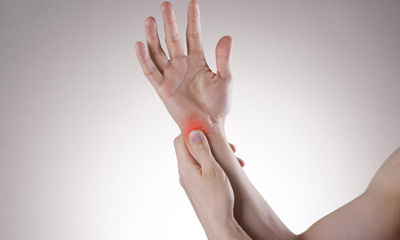How To Improve Grasping Power
My shoulders joint are paining I recently join gym is there any exercise which causes this or anything else? ...
Ask Free Question
Motion exercises shoulder pendulum ¬ see/saw assume the position shown (1), using either a chair or table to provide support. Allow your affected arm to hang, relaxed. Sway your body slowly to move the arm forward and backward (2) (see/ saw). Repeat this motion side to side and eventually to a circular motion (pendulum). Perform this circular exercise in both clockwise and counter-clockwise direction. Allow 1-2 minutes for this exercise. Do this exercise 3 times per day abduction - assisted stand with elbows bent to 90 degrees, holding the exercise rod in front of you (1). Using rod for assistance, gently raise your affected arm out to the side by pushing the rod with your good arm (2). Hold for 5-10 seconds. Perform 10 repetitions of this exercise 3 times per day. Abduction - assisted for advanced stager of rehabs stand holding the exercise rod as shown (1), with hand of the affected arm grasping the end cap. Using the rod for assistance, push with your good arm up and overhead to stretch your affected arm out to the side and overhead (2), keeping your affected arm as straight as possible during this motion. Hold in the upright position for 5-10 seconds. Slowly lower your affected arm. Repeat. Perform 10 repetitions of this exercise 3 times per day. Flexion - assisted stand as shown (1), with affected hand at the top of the exercise rod. Using the rod for assistance, stretch our arm higher overhead, directly out in front of you. (2). Maintain your affected arm as straight as possible during this motion. Hold extended for 5-10 seconds. Lower slowly. Repeat. Perform 10 repetitions of this exercise 3 times per day. Flexion - supine lie on your back as shown (1), holding exercise rod with both hands directly out in front of your. Raise both hands in unison overhead until they are as fully extended as is comfortable (2). For those with a weak back, raise your knees to provide support to your lower back during the exercise motion. Hold the end position for a few seconds and slowly return to the starting position. Repeat. Do 15 repetitions of this exercise 3 times per day. Wall crawls - spider stand facing near a wall as shown (1) slowly "walk" your fingers up the wall, moving up and down as well as side to side. Support your hand with the wrist as you extend farther up the wall. Perform this exercise for approximately 1 minute, covering as much of the wall surface as possible from a single standing position as is comfortable. Do this exercise 3 times per day. Extended wall crawl stand near a wall as shown, with your affected side towards the wall (1). Slowly "walk" your fingers up and down, then from side with your arm outstretched. Perform this exercise for approximately 1 minute, covering as much wall surface as possible from a single standing position. Do this exercise 3 times per day. Horizontal - rows anchor tubing to door jam or doorknob. Hold tubing by handle with your arm extended (1). With tension on the tubing, pull back on the handle until your elbow is along your side, as shown (2). Hold position for 3-5 seconds, slowly exited your arm to the original starting position. This exercise may be performed with your palm facing downward on the handle or palm facing upward on the handle flexion/adduction anchor tubing to door jam or doorknob. Hold tubing by handle with your thumb facing upward (1). Raise your arm up and across your body as shown, arm straight and extended (2). Hold for 3-5 seconds, slowly lower your arm to the original starting position. Repeat. Perform 10-15 repetitions of this exercise 3 times per day. External rotation anchor tubing to door jam or doorknob. Grasp handle with your thumb, stand with your unaffected side towards the door (1). Rotated arm outward unless is uncomfortable keeping elbow bent and as close to your side as is comfortable (2). Hold end position for 3-5 seconds and slowly relax. Repeat. Perform 10-15 repetitions of this exercise 3 times per day. Internal rotation anchor tubing to door jam or doorknob. Stand with affected side towards the door, grasping the handle with your thumb up (1). Rotate the arm inward, keeping the elbow bent and as close to your side as is comfortable (2). Hold end position for 3-5 seconds and slowly relax. Repeat. Perform 10-15 repetitions of this exercise 3 times per day. Extension anchor tubing to door jam at shoulder height, stand holding stretch band extended out in front of you, arm straight at shoulder length (a). Pull arm down and backward as shown until your hand is at your side (b). Hold end position for 3-5 seconds and slowly relax, return to start position. Repeat. Perform 10-15 repetitions of this exercise 3 times per day. Diagonal pull - for advanced stages of rehab anchor tubing to top of door jam; grasp tubing with thumb facing upward, arm straight, up and away from the body as shown (a). Start with affected side facing towards the door. Pull arm inward and downward, letting your head follow the movement. Allow your elbow to bend slightly but stay consistent as you move through the downward motion. Notice that the hand rotates as it crosses the body, ending with the thumb facing towards your at the endpoint (b). Hold the endpoint for 3-5 seconds, slowly relax and return to the start position. Repeat. Perform 10-15 repetitions of this exercise 3 times per day. Diagonal pull - part 2 anchor tubing to 6top of door jam; grasp tubing with thumb facing upward, arm straight, up and towards the body as shown (a). Start with unaffected side facing towards the door. Pull affected arm outward and downward, letting your head follow the movement. Allow your elbow to bend slightly but remain consistent as you move through the downward motion (b). Hold the endpoint for 3-5 seconds, slowly relax and return to the start position. Repeat. Perform 10-15 repetitions of this exercise 3 times per day. Abduction anchor tubing under your foot (a). While standing against a wall with your arm relaxd agaist your thigh, extend the arm up and outward in front of you approximately 45 degrees from the wall until shoulder heighth is reached. Try not to compensate with back or thigh mucles. Hold the end position for 3-5 seconds and slowly return to the rest posotion. Repeat. Perform 10 repetitions of this exercise 3 times per day. Shoulder flexion anchor tubing under your foot (a). Stand holding tubing along your side. Raise arm up until it is directly out in front of you at shoulder heighth (b). Hold the end position for 3-5 seconds then slowly return to the starting position. Repeat. Perform this excersise 3 times per day. Shoulder exercises and stretches regular exercises and stretches can keep your shoulder strong and flexible. A few things to remember before swinging in to exercises: •stop any exercise if you have more shoulder pain. It may be too soon for you to try. •watch your form. Exercising incorrectly can also cause or worsen shoulder problems. •warm up, even before deep stretching. Light shoulder rolls, gentle movements, or even a warm shower are all ways to warm up your muscles before exercise and stretching. Pendulum stretch for range of motion•stand and bend at the waist. •let your arm on the injured side hang straight down. •keep your neck relaxed. •move your arm in a circle up to 20 times. •do once or more times in a day. Overhead shoulder stretch•sit or stand to do this shoulder stretch. •intertwine your fingers in front of you. •bend your elbows and raise your arms above your head. You can also place your hands on your head or behind it. •gently squeeze your shoulder blades together to move your elbows back. •continue for up to 20 repetitions. Repeat 5 to 10 times a day. Physical therapyphysical therapy is the most common treatment for a frozen shoulder. The goal is to stretch your shoulder joint and regain the lost motion. It can take anywhere from a few weeks to nine months to see progress. A home exercise program of gentle range of motion exercises is important. If you don't see progress after six months of intense, daily exercises, speak to your doctor about other options. Medicationsto treat the pain and reduce your joint inflammation, your doctor may recommend an anti- inflammatory medication like aspirin, ibuprofen, or naproxen sodium. A steroid injection you’re your shoulder joint may also help. Home careplacing an ice pack on your shoulder for 15 minutes at a time several times per day can help to decrease pain. If you’re working with a physical therapist, the exercises can be done at home. Your physical therapist will provide instructions on the types of exercises you must do, how often to do them, and when to push yourself harder. Most people with a frozen shoulder can improve their condition without surgery.
Hyperintensity supraspinatus tendinosis I have this problem in my mri report. I was suffering from the pain from past 2 ...
Ask Free Question
Shoulder pendulum ¬ see/saw assume the position shown (1), using either a chair or table to provide support. Allow your affected arm to hang, relaxed. Sway your body slowly to move the arm forward and backward (2) (see/ saw). Repeat this motion side to side and eventually to a circular motion (pendulum). Perform this circular exercise in both clockwise and counter-clockwise direction. Allow 1-2 minutes for this exercise. Do this exercise 3 times per day abduction - assisted stand with elbows bent to 90 degrees, holding the exercise rod in front of you (1). Using rod for assistance, gently raise your affected arm out to the side by pushing the rod with your good arm (2). Hold for 5-10 seconds. Perform 10 repetitions of this exercise 3 times per day. Abduction - assisted for advanced stager of rehabs stand holding the exercise rod as shown (1), with hand of the affected arm grasping the end cap. Using the rod for assistance, push with your good arm up and overhead to stretch your affected arm out to the side and overhead (2), keeping your affected arm as straight as possible during this motion. Hold in the upright position for 5-10 seconds. Slowly lower your affected arm. Repeat. Perform 10 repetitions of this exercise 3 times per day. Flexion - assisted stand as shown (1), with affected hand at the top of the exercise rod. Using the rod for assistance, stretch our arm higher overhead, directly out in front of you. (2). Maintain your affected arm as straight as possible during this motion. Hold extended for 5-10 seconds. Lower slowly. Repeat. Perform 10 repetitions of this exercise 3 times per day. Flexion - supine lie on your back as shown (1), holding exercise rod with both hands directly out in front of your. Raise both hands in unison overhead until they are as fully extended as is comfortable (2). For those with a weak back, raise your knees to provide support to your lower back during the exercise motion. Hold the end position for a few seconds and slowly return to the starting position. Repeat. Do 15 repetitions of this exercise 3 times per day. Wall crawls - spider stand facing near a wall as shown (1) slowly "walk" your fingers up the wall, moving up and down as well as side to side. Support your hand with the wrist as you extend farther up the wall. Perform this exercise for approximately 1 minute, covering as much of the wall surface as possible from a single standing position as is comfortable. Do this exercise 3 times per day. Extended wall crawl stand near a wall as shown, with your affected side towards the wall (1). Slowly "walk" your fingers up and down, then from side with your arm outstretched. Perform this exercise for approximately 1 minute, covering as much wall surface as possible from a single standing position. Do this exercise 3 times per day. Horizontal - rows anchor tubing to door jam or doorknob. Hold tubing by handle with your arm extended (1). With tension on the tubing, pull back on the handle until your elbow is along your side, as shown (2). Hold position for 3-5 seconds, slowly exited your arm to the original starting position. This exercise may be performed with your palm facing downward on the handle or palm facing upward on the handle flexion/adduction anchor tubing to door jam or doorknob. Hold tubing by handle with your thumb facing upward (1). Raise your arm up and across your body as shown, arm straight and extended (2). Hold for 3-5 seconds, slowly lower your arm to the original starting position. Repeat. Perform 10-15 repetitions of this exercise 3 times per day. External rotation anchor tubing to door jam or doorknob. Grasp handle with your thumb, stand with your unaffected side towards the door (1). Rotated arm outward unless is uncomfortable keeping elbow bent and as close to your side as is comfortable (2). Hold end position for 3-5 seconds and slowly relax. Repeat. Perform 10-15 repetitions of this exercise 3 times per day. Internal rotation anchor tubing to door jam or doorknob. Stand with affected side towards the door, grasping the handle with your thumb up (1). Rotate the arm inward, keeping the elbow bent and as close to your side as is comfortable (2). Hold end position for 3-5 seconds and slowly relax. Repeat. Perform 10-15 repetitions of this exercise 3 times per day. Extension anchor tubing to door jam at shoulder height, stand holding stretch band extended out in front of you, arm straight at shoulder length (a). Pull arm down and backward as shown until your hand is at your side (b). Hold end position for 3-5 seconds and slowly relax, return to start position. Repeat. Perform 10-15 repetitions of this exercise 3 times per day. Diagonal pull - for advanced stages of rehab anchor tubing to top of door jam; grasp tubing with thumb facing upward, arm straight, up and away from the body as shown (a). Start with affected side facing towards the door. Pull arm inward and downward, letting your head follow the movement. Allow your elbow to bend slightly but stay consistent as you move through the downward motion. Notice that the hand rotates as it crosses the body, ending with the thumb facing towards your at the endpoint (b). Hold the endpoint for 3-5 seconds, slowly relax and return to the start position. Repeat. Perform 10-15 repetitions of this exercise 3 times per day. Diagonal pull - part 2 anchor tubing to 6top of door jam; grasp tubing with thumb facing upward, arm straight, up and towards the body as shown (a). Start with unaffected side facing towards the door. Pull affected arm outward and downward, letting your head follow the movement. Allow your elbow to bend slightly but remain consistent as you move through the downward motion (b). Hold the endpoint for 3-5 seconds, slowly relax and return to the start position. Repeat. Perform 10-15 repetitions of this exercise 3 times per day. Abduction anchor tubing under your foot (a). While standing against a wall with your arm relaxd agaist your thigh, extend the arm up and outward in front of you approximately 45 degrees from the wall until shoulder heighth is reached. Try not to compensate with back or thigh mucles. Hold the end position for 3-5 seconds and slowly return to the rest posotion. Repeat. Perform 10 repetitions of this exercise 3 times per day. Shoulder flexion anchor tubing under your foot (a). Stand holding tubing along your side. Raise arm up until it is directly out in front of you at shoulder heighth (b). Hold the end position for 3-5 seconds then slowly return to the starting position. Repeat. Perform this excersise 3 times per day. Shoulder exercises and stretches regular exercises and stretches can keep your shoulder strong and flexible. A few things to remember before swinging in to exercises: •stop any exercise if you have more shoulder pain. It may be too soon for you to try. •watch your form. Exercising incorrectly can also cause or worsen shoulder problems. •warm up, even before deep stretching. Light shoulder rolls, gentle movements, or even a warm shower are all ways to warm up your muscles before exercise and stretching. Pendulum stretch for range of motion•stand and bend at the waist. •let your arm on the injured side hang straight down. •keep your neck relaxed. •move your arm in a circle up to 20 times. •do once or more times in a day. Overhead shoulder stretch•sit or stand to do this shoulder stretch. •intertwine your fingers in front of you. •bend your elbows and raise your arms above your head. You can also place your hands on your head or behind it. •gently squeeze your shoulder blades together to move your elbows back. •continue for up to 20 repetitions. Repeat 5 to 10 times a day. Physical therapyphysical therapy is the most common treatment for a frozen shoulder. The goal is to stretch your shoulder joint and regain the lost motion. It can take anywhere from a few weeks to nine months to see progress. A home exercise program of gentle range of motion exercises is important. If you don't see progress after six months of intense, daily exercises, speak to your doctor about other options. Medicationsto treat the pain and reduce your joint inflammation, your doctor may recommend an anti- inflammatory medication like aspirin, ibuprofen, or naproxen sodium. A steroid injection you’re your shoulder joint may also help. Home careplacing an ice pack on your shoulder for 15 minutes at a time several times per day can help to decrease pain. If you’re working with a physical therapist, the exercises can be done at home. Your physical therapist will provide instructions on the types of exercises you must do, how often to do them, and when to push yourself harder. Most people with a frozen shoulder can improve their condition without surgery. Most muscle strains can be successfully treated at home. Minor muscle strains can be treated with rest, ice, compression, and elevation (rice). Rest avoid using your muscle for a few days, especially if movement causes an increase in pain. But too much rest can cause muscles to become weak. This can prolong the healing process. After two days, slowly begin using the affected muscle group, taking care not to overdo it. Ice apply ice immediately after injuring your muscle. This will minimize swelling. Don’t put ice directly on your skin. Use an ice pack or wrap ice in a towel. Keep the ice on your muscle for about 20 minutes. Repeat every hour on the first day. For the next several days, apply ice every four hours. Compression to reduce swelling, wrap the affected area with an elastic bandage until swelling comes down. Be careful not to wrap the area too tightly. Doing so can reduce your blood circulation. Elevation whenever possible, keep the injured muscle raised above the level of your heart.
Hi I am taking sizodon 2 mg and nexito 5 mg my doubt is can I prepare for govt exams using these meditations and can I d ...
Ask Free Question
Walnuts blue berries sunshine ginger no sugar no nonveg diet no eggs no mushrooms no fried foods citrus fruit, lime juice, little garlic, rest sound sleep. Prayers.
Having major depression since last 15 years. The first episode is very severe with complete numbness in brain resulting ...
Ask Free Question
You probably need a review of medication and psychotherapy to add to help recover and reinstill confidence in you. Often lack of confidence and self esteem can impair memory.
I am having major depression since last 15 years. The first episode is very severe with complete numbness in brain resul ...
Ask Free Question
Dear lybrate-user, because of continuous lamictal 300 mg, you are able to experience only mild episodes of depression. Otherwise, it would have been severe. For this mild symptoms of memory loss, you need antidepressants. You are already on paroxetine 50 mg. Your psychiatrist will decide about the dose and addons like buspirone. You can try mindfulness practice so that the input to your memory is increased.
I had severe depressive episode 10 years back with complete numbness in brain. My short-term memory got severely affecte ...
Ask Free Question
You must take some good vitamin supplements and eat five or six badaam soaked in milk overnight and drink that milk. Neurobion is a good vitamin supplement that you can take. Also avoid smoking and no alcohol as they degenerate the brain cells.
I am having major depression since last 15 years. The first episode is very severe with complete numbness in brain resul ...
Ask Free Question
You seem to be taking a nice combination of medications, depression by itself can also produce cognitive deficits (memory issues). You may need another one for that particular symptom, as other medications currently prescribed may not be able to take care of it. All the best.
Male, 18. I have a problem of forgetfulness, I forget my studies what I memorize after 2-3 days probably due to stress & ...
Ask Free Question
Meditation n keeping mind fresh is the key do prananayam n meditation under expert guidance which will help in increase in ur concentration memory n grasping power daily dont mug up the content try to understatnd the concepts first keep hydrated ur mind n body try playing carrom chess or other outdoor activity for keeping ur memory power shary !
I am 48 years old. Recently"Trigger finger" has developed on my right thumb. Very surprised. What is the reason and what ...
Ask Free Question
Trigger finger treatment varies depending on its severity and duration. Medications Nonsteroidal anti-inflammatory drugs — such as ibuprofen (Advil, Motrin IB) or naproxen (Aleve) — may relieve the pain but are unlikely to relieve the swelling constricting the tendon sheath or trapping the tendon. Therapy Conservative noninvasive treatments may include: Rest. Avoid activities that require repetitive gripping, repeated grasping or the prolonged use of vibrating hand-held machinery until your symptoms improve. If you can't avoid these activities altogether, padded gloves may offer some protection. A splint. Your doctor may have you wear a splint at night to keep the affected finger in an extended position for up to six weeks. The splint helps rest the tendon. Stretching exercises. Your doctor may also suggest gentle exercises to help maintain mobility in your finger. Surgical and other procedures If your symptoms are severe or if conservative treatments haven't helped, your doctor might suggest: Steroid injection. An injection of a steroid medication near or into the tendon sheath may reduce inflammation and allow the tendon to glide freely again. This is the most common treatment, and it's usually effective for a year or more in most people treated. But sometimes it takes more than one injection. For people with diabetes, steroid injections tend to be less effective. Percutaneous release. After numbing your palm, your doctor inserts a sturdy needle into the tissue around your affected tendon. Moving the needle and your finger helps break apart the constriction that's blocking the smooth motion of the tendon. This treatment may be done under ultrasound control, so the doctor can see where the tip of the needle is under the skin to be sure it opens the tendon sheath without damaging the tendon or nearby nerves. This procedure is usually done in the doctor's office or in an office procedure room. Surgery. Working through a small incision near the base of your affected finger, a surgeon can cut open the constricted section of tendon sheath. This procedure is usually done in an operating room.
Hi, I am a chronic Major depression patient since more than 15 years. I had very severe major depressive episode 15 year ...
Ask Free Question
I think you have done reasonably well for such a long period of depression. I am quite disappointed that you did not or were not guided to seek therapeutic help for your depression in tandem with the medication. It is still not too late to seek counseling help and learn some skills, tools, and techniques to help cope with your disorder. You will regain more composure an feel of higher spirits over time and may need to rely less on medication if advised. It will help in the meantime to do the following sincerely because you could resolve the problem better with good cooperation: Have a good night’s sleep, have a good breakfast of more proteins, meditate often, remain free of stress, eat a lot of fiber, nuts, avocado, exercise regularly, eat dark chocolate, do Yoga meditation exercises, spend time in nature or gardening, etc. I suggest you do the opposite of what this depression makes you feel like doing (actually, not doing): you will need to fight this condition. You must become active; stay upright during the daylight time; meet people; never sleep during the day, wake up by 6 am every day, play some active games, especially contact games, do physical exercises, talk to people and join some social clubs, attend Yoga classes etc. Watch sitcoms on TV or comedies and cheer yourself up. Go for excursions in groups, for outings, camps, conferences, and religious conventions. Get a pet dog and spend time training it, exercising it and relating to it. Expose yourself to some sunlight every day, at least, 30 minutes but not in the scorching heat. Whatever happens, please incorporate these three important adaptations in your life: always be responsible, be respectful, and be functional. If you did these three, lots of things will go well in life. Please pray and have faith in God to alleviate your sufferings. Don’t wait for others to help. Use your own motivation, which might be at its lowest, but persevere and win this battle. Above all to be really happy, you need to live in love and for love. Learn all about emotions and how to handle them and that will get you out of the depression rather easily and quickly. A counselor is there only to facilitate you, all the hard word must come from you, and your cooperation with that person is very critical for your success. Be positive every day and learn to be contented with what you have. Do some left brain exercises: it is the happy brain and is good with short term memory. Here are a few suggestions: shut your left nostril and breathe, move your eyes from right to left and vice versa for at least half a minute at a time, and do calisthenic exercises with some form of counting, regularly. Whatever happens please cooperate with the therapy and do not discontinue until the condition is completely resolved.





